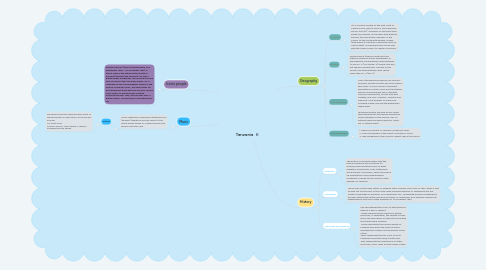
1. Iconic people
1.1. Freddie Mercury (Born Farrokh Bulsara, on 5 September 1946 – 24 November 1991) in Stone Town in the British protectorate of Zanzibar (present day Tanzania). He was a British singer-songwriter, record producer and lead vocalist of the rock band Queen. He is regarded as one of the greatest singers in the history of popular music, and was known for his flamboyant stage persona and four-octave vocal range. As Zanzibar was a British protectorate until 1963, Mercury was born a British citizen. He remained so throughout his life.
2. Music
2.1. Music listened by Tanzanians stretches from (Bolingo) traditional African music to the string-based taarab to a distinctive hip hop known as bongo flava.
2.1.1. Artists
2.1.1.1. Tanzanian musicians have become some of the best artists in East Africa. Art musicians include: Mr. Elliot Andy Dionys Mbilinyi, John Mgandu, Sabinus KombaImani and Sanga.
3. Geography
3.1. Location
3.1.1. It is a country located on the east coast of Central Africa, with an area of una superficie de 947 300 km². It borders on the north with Kenya and Uganda, on the west with Rwanda, Burundi, the Democratic Republic of the Congo, on the south with Zambia, Malawi (with whom it maintains a territorial claim on Lake Malawi), Mozambique and on the east with the Indian Ocean. Its capital is Dodoma.
3.2. climate
3.2.1. Tanzania has a tropical climate but has regional variations due to topography. In the highlands, temperatures range between 10 and 20 °C (50 and 68 °F) during cold and hot seasons respectively. The rest of the country has temperatures rarely falling lower than 20 °C (68 °F).
3.3. Flora and fauna
3.3.1. Over a thousand bird species are found in Tanzania, and the country has nine Endemic Bird Areas. It is also home to important populations of many iconic and threatened species including black rhino, elephant, common chimpanzee, African wild dog, cheetah, and lions. Offshore, Tanzania also supports a rich diversity of marine life including manta rays and the gargantuan whale shark. Tanzania’s wildlife, extolled as the "finest safari experiences and wildlife spectacles found anywhere on the planet", has 40 national parks and game reserves. There are 17 national parks.
3.4. Interesting facts
3.4.1. 1. Nearly 30 Percent of Tanzania is National Parks. 2. Mount Kilimanjaro is the Tallest Mountain in Africa. 3. Lake Tanganyika is the Second Largest Lake in the World.
4. History
4.1. Prehistory
4.1.1. The history of Tanzania begins with the birth of humanity and continues for millennia, becoming the scene of great migratory movements, Arab settlements and European colonialism, which would end up propitiating a solid independence movement, prelude to the current United Republic of Tanzania.
4.2. Foundation
4.2.1. The African Great Lakes nation of Tanzania dates formally from April 26 1964, when it was formed out of the union of the much larger mainland territory of Tanganyika and the coastal archipelago of Zanzibar. On 9 December 1961, Tanganyika became independent, though retaining the British monarch as Queen of Tanganyika, and Zanzibar received its independence from the United Kingdom on 10 December 1963,
4.3. Flag origin and meaning
4.3.1. The flag retained the colors of both previous flags as a sign of respect. ·Green represents the richness in natural resources, in vegetation, the fertility of their lands, the importance of agriculture and they link it with being a people. ·Yellow represents the mineral wealth of Tanzania and recalls the need for good management of them for the welfare of the nation. ·Black represents the skin color of most Tanzanians and they show it with pride. ·Blue represents the importance of water resources, rivers, lakes and the Indian Ocean.

